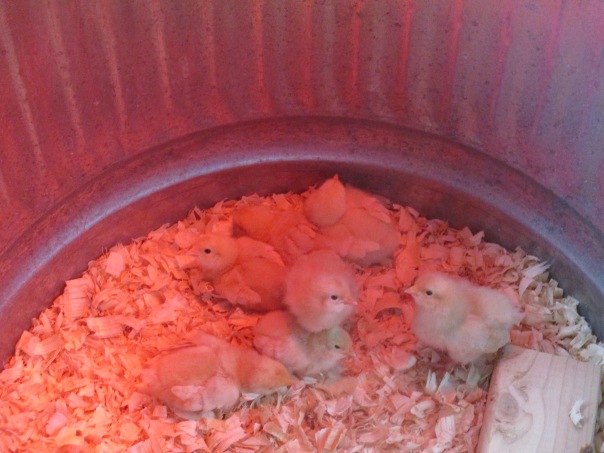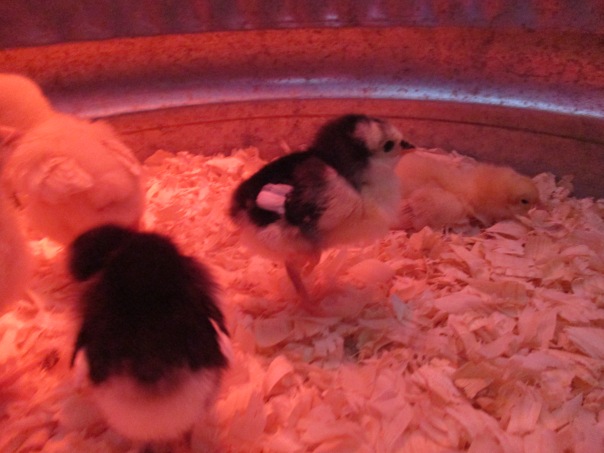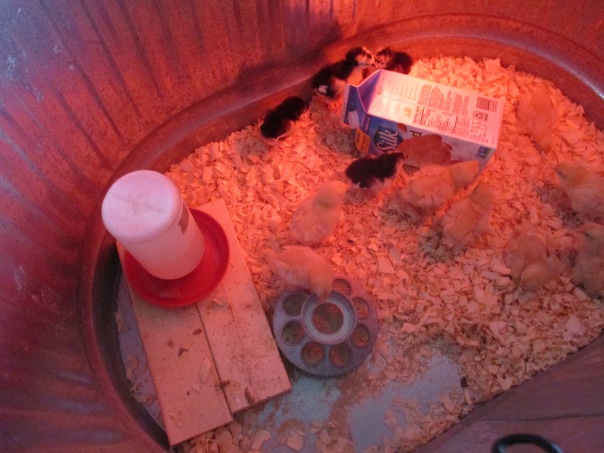If you walk into the local farm store this time of year you can generally hear them before you see them. Peep, Peep, Peep-peep, peep, peep-peep…………………………………It’s such a precious sound you can’t help but go take a look. If you are not in the market for chicks taking a look might not be a good idea because when you see how cute they are you will certainly want to take one or a dozen home.
Buying chicks from the farm store was actually what my husband planned when he went there on Tuesday. After some debate we decided to replace part of the flock we lost. Even though the remaining flock is currently giving us between 8 and 12 eggs a day, far more than we need for our own use, most of the hens that remain are between 3 and 5 years old. The main reason we did decide to get more is because for about 6 to 8 weeks during the winter egg production slows down substantially. This past winter we observed that it was primarily our first year layers that were still laying eggs. During that time period they continued to give us enough eggs to meet our needs. In looking ahead to next winter we decided that getting more chicks now was a good move.
He had to go to two different stores in order to find the breed(s) we wanted.

Our first choice was Buff Orpingtons. Of the four breeds that we have raised so far these are our favorite. In addition to being a hardy breed, good layers and good foragers, they are docile and friendly.
They can be quite entertaining when we opt for an evening of chicken TV.
We also decided on a second breed that we have never raised before. Black Australorps. This breed is supposed to be much like the Orpington except harder to spell. Just kidding, they supposedly lay more eggs than the Orpington. They certainly are adorable chicks.
Black Australorps. This breed is supposed to be much like the Orpington except harder to spell. Just kidding, they supposedly lay more eggs than the Orpington. They certainly are adorable chicks.

Peep, peep, peep-peep, peep,peep, peep-peep, peep……………………………………
Acting as surrogate parents we got out a galvanized stock tank that works well as a brooder for the first couple of weeks. We used wood shavings for bedding and gave them food and water. I dipped each beak in the water because I was not certain if they had learned to drink yet. We use a heat lamp clamped to the stock tank to keep the chicks warm enough. I also checked each chick’s butt to see if they had poop on it. This is a condition called pasty butt, and if the poop blocks the chicks vent it can cause death. I did find two of the buffs with this condition, so I used a warm wet washcloth to soften the dried poop and remove it.
My husband always likes to make the chicks a little playhouse out of a Silk carton. He cuts a hole in a side so the chicks can go in and out. So far this group seems more fascinated by pecking at it. It’s pretty amazing how much noise those little beaks can make when they are pecking on something hard. It can actually sound like someone knocking on the door. They have started to hop on top of the carton, and I’m sure it won’t be long before the venture inside. It’s surprising how many of them can cuddle up inside that carton.
In about 2 weeks I expect we will see the peepers craning their necks trying to see the world beyond the stock tank. They will also have a lot of their feathers and be discovering their wings. They will be able to get on top of the container that holds their water and attempt to fly out of the brooder. Some might succeed. At this time we will have to move them to what I’ll refer to as our second stage brooder. I don’t have any pictures of this so I will give you an update with pictures when the move occurs.


They are adorable! I better not go into any farm stores lol. I liked your ‘chicken TV’ very funny,
LikeLike
LOL. Once the weather warms up I’m sure we will spend many evenings watching “chicken TV” It’s way better than anything on cable.
LikeLiked by 1 person
When it’s cabin season we sit on our deck as the sun goes down and watch ‘the show’, the little insects flying over our garden are highlighted in the setting sun, its beautiful.
LikeLiked by 1 person
They are so cute! You’re the second person I’ve come across talking about raising chickens…maybe it’s a sign! Haha idk about that. I’m not sure I’m up for the task!
LikeLiked by 1 person
They do take some work but the fresh eggs make it worth all the work. Thanks for visiting.
LikeLiked by 1 person
They are adorable indeed.That’s great that you are planning for the future.
LikeLike
Planning ahead is an important part of providing our own food. So many foods are seasonal – we have to plan to grow enough to get us through the year and how to preserve them. I have read that hens will continue to lay during the winter if you add light to their coop. Also eggs can be preserved by freezing. I had not read about keeping first year layers to get us through the winter – but this has been our experience and it is what works best for us.
LikeLiked by 1 person
Freezing eggs? I have never heard of this. Have you actually tried it for yourself? Do you freeze them fresh, or boiled? How do you go about defrosting them?
LikeLike
They are frozen raw but the yoke and white are mixed together like scrambled. Defrosted by letting them sit in the fridge overnight or quicker at room temp. I haven’t eaten them just as eggs but they work well for baking. I froze them as individuals in a muffin pan so I could use just one at a time.
LikeLiked by 1 person
So you crack them open before freezing?
Very interesting.
LikeLike
Yes, freezing them in the shell would cause the shell to crack, and I think they need to be mixed before freezing because freezing just the yolk makes it hard – kind of dried out, but if it is mixed with the white it freezes well and thaws.
LikeLiked by 1 person
I will be sure to check it out at some point. Thank you for the idea.
LikeLiked by 1 person
I am not sure if you are into quotes but if you are: here is a challenge for you 🙂
https://beehalton.com/be-grateful-with-schopenhauer-3-day-quote-challenge/everything
LikeLike
Hi Ruth! All the best for the chicks. May they grow well and produce lots of eggs. I remembered your post about the chicken statue before. Are you having them as free range when they grow bigger or will you put them on their house?
LikeLiked by 2 people
Thanks Graci. When they get bigger they will join the rest of the flock at the farm where they will free range during the day and spend the nights in the coop. Our free ranging has become a little more restricted since we lost so many to the coyote. When we are at the farm we let them roam the whole acreage but when we are not there we keep them fenced in the chicken yard – still considered free range- for their own safety.
LikeLiked by 1 person
Oh I think I remembered that in one of your post Ruth. It costs a few more bucks to buy a free range eggs here than the caged ones but surely they are tastier. Hope this time the cayote wouldn’t sneak around anymore. Also a good weather for the chickens would be lovely!
LikeLiked by 1 person
Free range eggs in the grocery store here always cost more than caged but in the US the definition of free range can be hens that are able to roam but rarely even get out side. I have never bought grocery store free range but hens that can naturally forage for their own food do produce the best eggs.
LikeLiked by 1 person
Oh that’s interesting to know. I think here in Aus, free range eggs means they can actually roam outside the field. I am not very certain. But it’s really an advantage having chickens of your own. Hope everything goes well this time.
LikeLike
Oh that’s interesting to know. Hope everything goes well with your chickens this time. Hope no more cayote attack.
LikeLike
I’ve never tasted fresh eggs but I hear they are good!
LikeLiked by 2 people
Oh yes, fresh eggs from free range chickens have such good flavor. You don’t get that from grocery store eggs.
LikeLike
Those chicks are so cute… nearly makes me want to get some. Nearly…
LikeLiked by 2 people
They are irresistible. 🙂
LikeLiked by 1 person
The chicks are adorable–I didn’t know the details of raising them. Thanks for the post.
LikeLiked by 1 person
You’re welcome. Glad you enjoyed it. 🙂
LikeLiked by 1 person
What a fantabulous post!
A thoroughly enjoyable read. Thank you! ~ Cobs. 🙂
LikeLiked by 3 people
Thank you. I’m so happy you enjoyed it! 🙂
LikeLiked by 1 person
Awe…. so cute!
LikeLiked by 2 people
I remember visiting a hatchery on a school field trip in elementary school. The chicks were indeed cute. Yours are cute too!
LikeLiked by 3 people
It’s funny, as they grow they go from irresistibly cute to a very scraggly (teenage) stage before they mature into beautiful full grown hens. Much like people I suppose. 🙂
LikeLiked by 2 people
Oh Ruth!!! you will love your black australorps. They are some of my favorite birds! They are funny, friendly and around here they are great for keeping an eye out for hawks.
I need to get myself down to the farm store also because my girls are also over 3 years old and slow down to much in the winter.
LikeLiked by 1 person
Sounds like the australorps will be a great fit for our farm. I love when our girls can give us enough fresh eggs year round that I don’t have to buy eggs. 🙂
LikeLiked by 1 person